Recovery Between Matches: Effective Strategies for Faster Return
Updated On: August 23, 2025 by Aaron Connolly
Understanding Recovery Between Matches
Football matches put the body through some serious physical demands. These demands create different types of fatigue, and each one needs its own recovery plan.
Biochemical markers let coaches and players check how well the body bounces back. They can see when players are actually ready to go again.
Physiological Demands of Back-to-Back Fixtures
Football is rough on the body. Players run, jump, and change direction constantly.
Most players cover 10-12 kilometres in a match, with a lot of sprints and tackles mixed in.
Muscle damage happens when players push through repeated high-intensity efforts. Fast-twitch and slow-twitch muscle fibres burn through their glycogen supplies.
Research says this loss of glycogen really hurts sprinting and agility.
The heart works overtime too. Players’ heart rates often hit 85-95% of their max for long stretches.
That puts a lot of strain on the heart and blood vessels.
Right after a match, you’ll usually see:
- Muscle strength drops for a few days
- Muscles are running on empty
- Inflammation spikes throughout the body
- Stress hormones like cortisol shoot up
When matches come just 48-72 hours apart, things get even trickier. The body hasn’t fully recharged or fixed muscle damage from the last game.
Types and Causes of Fatigue
Fatigue in football isn’t just one thing. Each type needs its own solution.
Physical fatigue comes from running out of energy and muscle damage. Glycogen stores in the muscles get wiped out, making it harder to sprint or jump.
Central nervous system fatigue shows up when the brain can’t send signals to the muscles fast enough. Players react slower and lose coordination. This kind of fatigue often lingers longer than the physical stuff.
Mental fatigue creeps in from all the thinking and stress during matches. Decision-making, tactical awareness, and focus drop off. Stress just makes it worse.
Age and position matter:
- Younger players bounce back quicker
- Midfielders, who run the most, get hit the hardest
- Defenders, with all their sprinting and stopping, have their own struggles
The environment plays a part too. Hot weather dries players out and adds heat stress. Traveling messes with sleep and makes recovery harder.
The Role of Biochemical Markers in Measuring Recovery
Biochemical markers give teams a peek inside the body, showing how recovery is going.
Blood and saliva tests pick up on things you can’t see from the outside.
Creatine kinase (CK) tells you about muscle damage. High CK means the muscles are still repairing. It usually stays up for 48-72 hours after a tough match.
Lactate dehydrogenase (LDH) shows if cells are stressed or damaged. High LDH means the body is still fixing tissues from the last game.
Cortisol tracks stress and recovery. If it stays high for too long, recovery isn’t done and overtraining is a risk. Morning cortisol checks are the most reliable.
Performance markers help too:
- Jump height checks explosive power
- Sprint times show how well nerves and muscles are working
- Heart rate variability tracks the nervous system’s recovery
Not every player is the same. Some feel tired even when their biochemical markers look normal. Others have high markers but feel good to play.
Teams now use these markers to help decide who plays. If a player’s CK stays high after 48 hours, coaches might ease off their training or give them a rest.
Combining data from these tests and how players actually feel gives the clearest picture of recovery.
Time Course of Recovery

Recovery isn’t instant. Different body systems bounce back at different speeds.
Physical performance usually comes back within 48 hours. Biochemical markers can take up to 72 hours to settle down.
Recovery Timeframes After a Match
Right after a match, players lose some sprint speed and jumping ability.
These performance markers usually bounce back within 48 hours.
Jump tests drop the most in the first 12 to 24 hours. Basketball players, for example, sometimes need even longer to recover than footballers.
Sprint performance takes the biggest hit right after the final whistle.
Key Recovery Milestones:
- 0-12 hours: Peak fatigue, lowest performance
- 24-48 hours: Most abilities are back to normal
- 48-72 hours: Biochemical markers finally catch up
Some players need up to 96 hours to fully recover their sprint speed. Match intensity and fitness matter a lot here.
Blood markers tell a different story. Creatine kinase can stay high for 42 to 120 hours after a game.
Football and rugby players often see higher peaks because of more collisions and hard efforts.
Influence of Training Load and Competition Level
Amateurs take longer to recover than pros.
Lower-level players often need 72 hours or more to feel normal again.
Elite players recover quicker thanks to better fitness and smarter recovery routines.
Premier League players handle tough schedules better than lower-division athletes. Their bodies get used to heavy training all season.
Professional recovery systems really help speed things up.
Recovery by Competition Level:
- Professional: 24-48 hours is typical
- Semi-professional: 48-72 hours is more common
- Amateur: 72+ hours is normal
Playing too many matches in a week slows down recovery. Players who compete every 72 hours start to show signs of fatigue piling up.
Coaches usually cut back on training between games to help players recover.
Heavy training weeks slow things down even more. Intense training means players need longer breaks between matches.
Indicators of Full Recovery
Teams use several markers to track recovery.
Jump height and sprint times are quick ways to check if someone’s ready.
Blood tests dig a bit deeper. Cortisol spikes after matches, then drops back down within 14-72 hours.
Testosterone dips at first, then often climbs above normal after a day or two.
Recovery Tracking Tools:
- Countermovement jump height
- 10-metre sprint times
- Heart rate variability
- Wellness questionnaires
- Blood creatine kinase
Players might feel ready before their bodies are. Performance markers can look good even if muscle damage is still there.
That’s why some players feel fine but still carry hidden fatigue.
Sleep quality is a big deal. Bad sleep stretches out recovery.
Getting nutrition right helps players get back to normal faster.
Markers of Recovery and Fatigue
Tracking specific biomarkers gives teams a clearer idea of when players are truly ready.
Creatine kinase levels show muscle damage, while countermovement jump tests check how well nerves and muscles have bounced back.
Creatine Kinase and Muscle Damage
Creatine kinase (CK) is the gold standard for measuring muscle damage in footballers.
This enzyme leaks into the blood when muscles get tiny tears from intense movements.
CK usually peaks 24-48 hours after a match and can stay up for 72 hours.
Pros often see CK jump by 200-500% after a tough match.
Quick tip: Every player has their own normal CK range. Teams set personal baselines instead of using one-size-fits-all numbers.
Other muscle damage markers:
- Lactate dehydrogenase (LDH): Peaks sooner than CK
- Myoglobin: Rises and falls within 24 hours
- C-reactive protein: Shows inflammation
Heads up: CK isn’t the whole story. Some players play well even with high CK.
Countermovement Jump and Performance Monitoring
The countermovement jump (CMJ) test checks explosive power and neuromuscular readiness.
Players jump as high as they can from a standstill. Force plates measure a few things.
Key CMJ numbers:
- Jump height: The classic metric
- Peak power output: How much force they generate
- Rate of force development: Measures explosive strength
Research shows CMJ usually recovers within 48-72 hours after a match.
Muscle damage markers often stay high even after jump performance returns.
Teams get the best results by testing players at the same time each day, usually before training.
A lot of teams now use phone apps or portable gadgets for quick checks.
In practice: If jump height drops by 10%, recovery isn’t done yet.
Other Biochemical and Physical Measures
Cortisol shows stress and usually stays up for 24-48 hours after matches.
Saliva samples make testing easy and regular.
Heart rate variability (HRV) shows how well the nervous system is recovering. Lower HRV means the body’s still stressed.
Other recovery markers:
| Marker | Recovery Timeline | Testing Method |
|---|---|---|
| Muscle soreness | 48-72 hours | Subjective scales |
| Sprint performance | 48-72 hours | 10m/30m sprints |
| Perceived exertion | 24-48 hours | RPE scales |
| Sleep quality | 2-3 nights | Wearables |
Testosterone-to-cortisol ratio helps spot overtraining or incomplete recovery. If the ratio drops, fatigue is building up.
Teams now use panels that combine several markers instead of relying on just one.
This combo gives a more complete picture of each player’s recovery.
Effects of Inadequate Recovery
If players don’t recover properly between matches, both their bodies and minds take a hit.
Muscle fatigue stacks up, and decision-making gets worse. That’s a dangerous combo for injuries and poor performance.
Risk of Injury and Underperformance
Players who play again with less than 72 hours’ rest are six times more likely to get injured.
Muscles haven’t fully repaired, so strains and tears happen more easily.
Sprint speed drops a lot when recovery is rushed. Research says muscles need at least 72 hours to recover, even if players feel okay after 48.
Premier League players get slammed during busy fixture periods. Two games a week for weeks on end leads to chronic fatigue that builds up over the season.
When the brain hasn’t recovered, players make worse decisions. Bad passes, missed tactics, slow reactions—it all adds up.
The body’s repair process stalls without enough rest. Small muscle tears from the last match don’t heal before the next game adds more damage.
Signs of Chronic Fatigue
Mental fatigue shows up as poor focus and irritability. Players can’t concentrate in training and make unusual mistakes.
Physical signs:
- Muscle soreness that lingers past 48 hours
- Stiffness that doesn’t go away with movement
- Resting heart rate stays high
- Trouble sleeping even when tired
Performance markers make the problem obvious. Jump height drops, sprint times slow, and strength numbers fall below normal.
Blood markers like creatine kinase stay high, showing ongoing muscle damage. Cortisol stays up, signaling constant stress.
Players often say their legs feel heavy in matches. They just can’t hit top speed or keep up intensity for a full 90 minutes.
Impact on Mental and Physical Wellbeing
When players don’t recover well, their sleep quality takes a hit. They might find themselves tossing and turning or waking up a lot, which means real rest just doesn’t happen.
Mental health struggles show up in different ways:
- Players get anxious about their performance.
- Sometimes, they stop enjoying the game.
Mood swings and irritability creep in. Motivation for training drops, even for the most dedicated.
Chronic fatigue chips away at the immune system. Players seem to catch every cold going around and bounce back slowly from even minor illnesses.
Appetite can get weird during poor recovery spells. Some players just aren’t hungry, while others go after junk food that does nothing for recovery.
Constant tiredness and stress strain social relationships. Players might pull away from teammates or snap at family and friends.
If this cycle keeps going, long-term health issues show up. Chronic inflammation, hormone problems, and nagging joint pain can haunt players well after their careers end.
Active Recovery Methods
Active recovery gets players back on their feet faster. Gentle movement keeps blood flowing and helps clear out waste products like lactic acid.
Honestly, these gentle movements beat just lying around for reducing muscle soreness and prepping your body for the next match.
Low-Intensity Exercise
Light cardio keeps recovery moving without overloading tired muscles. A ten-minute walk or a slow bike ride gets blood pumping to sore spots.
Swimming’s a favorite for footballers. The water supports you while you move all your muscle groups. Keep it chill—gentle breaststroke, not racing laps.
Best low-intensity options:
- Walking (15-20 minutes, easy pace)
- Easy cycling (10-15 minutes, low effort)
- Pool walking or gentle swimming
- Light jogging (only if you’re feeling good)
Don’t let your heart rate climb above 60% of max. You should be able to chat the whole time. This isn’t about training hard—it’s about helping your body heal.
Jump into active recovery within 2-3 hours after your match. Muscles respond best when they’re still warm from competition.
Stretching and Flexibility Work
Static stretching after matches helps muscles relax and reduces stiffness. Focus on the big muscle groups that worked hardest.
Hold each stretch for 20-30 seconds. Don’t bounce—just a gentle pull, no sharp pain. Breathe deep and let tension go.
Key stretches for footballers:
- Hip flexors (all that running)
- Hamstrings and calves (from sprinting)
- Quadriceps (kicking and jumping)
- Glutes and IT band (often ignored but crucial)
Dynamic stretching helps too. Try gentle leg swings and arm circles to keep joints moving. Save the deep stretches for when you’ve cooled down.
Pair stretching with deep breathing. This activates your parasympathetic nervous system and speeds up recovery.
Foam Rolling and Self-Massage
Foam rolling breaks up tight spots and boosts blood flow to sore areas. Roll slowly over each muscle group and pause on the tender bits for 30-60 seconds.
Technique tips:
- Roll from joint to joint (ankle to knee, knee to hip)
- Use moderate pressure—discomfort is fine, sharp pain isn’t
- Spend extra time on IT band, calves, and glutes
- Roll for 1-2 minutes per muscle group
A massage ball digs deeper than a foam roller. Press it against a wall for your upper back or under your foot for some relief.
Hands work too. Use firm, circular motions on your calves and thighs. A bit of oil or balm helps prevent skin friction.
Start foam rolling 30-60 minutes after your match. Let your muscles cool down, but don’t wait too long or you’ll get stiff.
Hydrotherapy and Cryotherapy Approaches
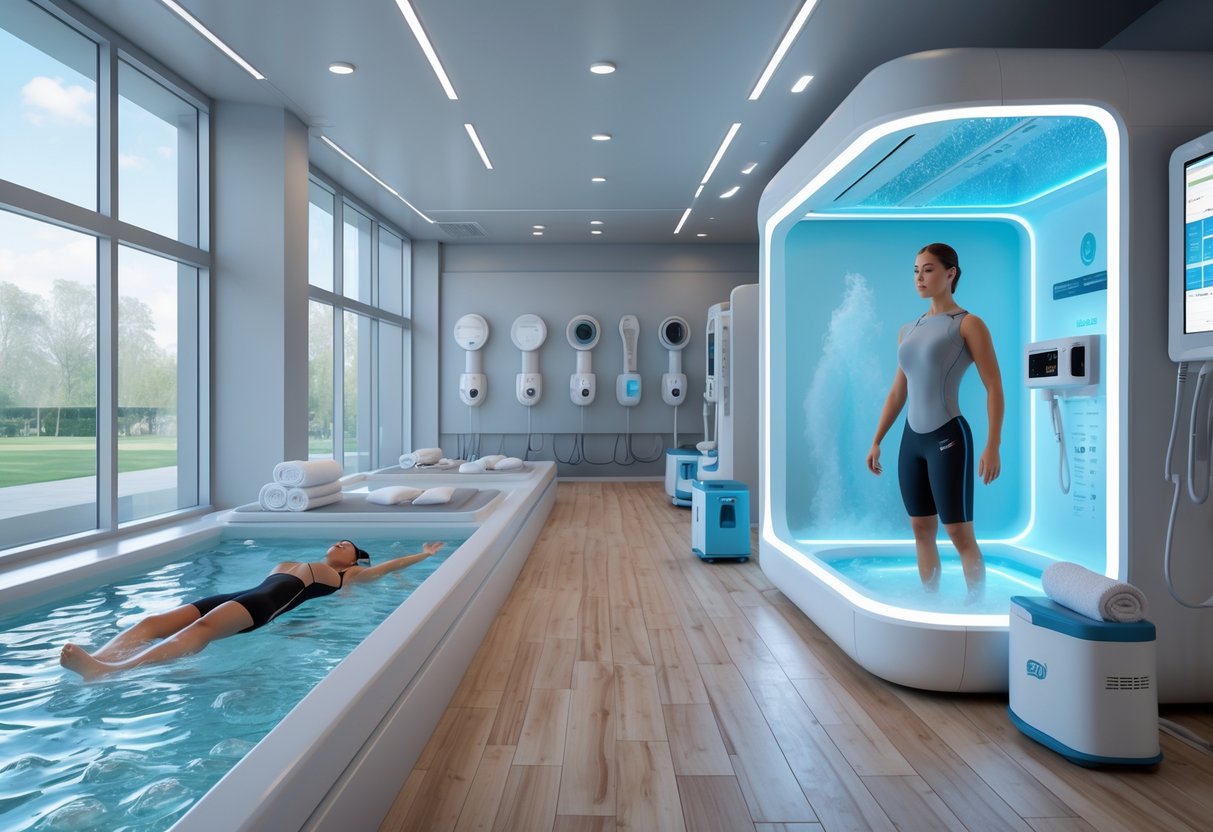
Water-based recovery uses temperature changes to fight muscle soreness and help you heal between matches. Cold water immersion knocks down inflammation, while contrast therapy switches between hot and cold to boost circulation.
Cold Water Immersion and Ice Baths
Cold water immersion means sitting in water between 10-15°C for 10-20 minutes after matches. It works by tightening blood vessels and reducing swelling.
Pro teams often roll out portable ice baths that cost a few hundred quid. Plenty of players just start with cold showers at home.
Key benefits:
- Less muscle soreness within 24-48 hours
- Faster jump recovery
- Lower muscle damage markers
Water temperature matters a lot. Under 15°C works best for cutting inflammation. Sessions over 20 minutes don’t add much.
Many esports facilities now have cold plunge pools. Players jump in after tough practice or matches.
Heads up: Start with 5-10 minute sessions to avoid shock. Skip ice baths if you have heart issues.
Contrast Water Therapy
Contrast water therapy means switching between hot (36-40°C) and cold (10-15°C) water. This creates a pumping action to flush out waste from muscles.
A typical routine goes like this:
- 3-4 minutes in hot water
- 1 minute in cold water
- Repeat 3-4 times
- Always end on cold
Recent studies say this is the best for recovering markers like creatine kinase. Pro teams use fancy contrast pools, but you can do it at home with hot baths and cold showers.
The temperature swings make the difference. Hot water boosts blood flow, cold reduces swelling and flushes waste.
Quick tip: Try contrast showers after long gaming sessions—90 seconds hot, 30 seconds cold, three rounds.
Pool-Based Recovery
Swimming pools offer unique recovery perks thanks to hydrostatic pressure and buoyancy. Water pressure cuts swelling and supports your weight.
Active recovery sessions in the pool usually last 20-30 minutes. Light swimming or walking in chest-deep water keeps blood moving without pounding your joints.
Pool temps between 28-32°C feel best for active recovery. You can move easily and get mild cooling.
Many esports centers feature hydrotherapy pools. Players use them for:
- Gentle movement to avoid stiffness
- Less joint stress than land workouts
- Mental relaxation
Pro tip: Local leisure centers often have good pools. Book off-peak times to avoid crowds that mess with your routine.
Research suggests pool-based recovery improves next-day performance more than just resting. The gentle resistance keeps blood flowing without tiring you out.
Manual Recovery Interventions

Manual recovery helps muscles bounce back by applying pressure and support right where you need it. These hands-on techniques boost blood flow and ease muscle tension after tough matches.
Massage Therapy and Compression Garments
Massage therapy stands out as one of the best manual recovery options. A good massage improves circulation and helps clear out waste from tired muscles.
You can try different massage techniques between matches. Deep tissue massage targets stubborn knots. Sports massage focuses on the muscles you used most.
Self-massage options:
- Foam rollers for big muscle groups
- Massage balls for tight spots
- Handheld massage gadgets
Massage cuts down soreness and stiffness. A 15-20 minute session within a couple hours after your match works wonders.
Compression garments keep steady pressure to support recovery. These snug clothes help blood return to your heart.
Compression gear reduces swelling and muscle shake, so you feel less sore the next day.
Main benefits:
- Less muscle fatigue
- Better circulation
- Less swelling after matches
Wear compression garments for 2-8 hours post-match for the best effect.
Compression Gear During Travel
Traveling between matches makes recovery even trickier. Sitting for ages slows blood flow and stiffens you up.
Compression socks are a must during flights or bus rides. They keep blood from pooling in your legs and lower clot risk.
Graduated compression works best for travel—tighter at the ankle, looser up the leg.
Travel compression checklist:
- Compression socks (15-20 mmHg)
- Calf sleeves for easy on/off
- Full tights for long trips
Put on compression gear before you start traveling. Keep it on during your journey and for another hour or two after you arrive.
A lot of pro teams require compression during all team travel. Better circulation means you show up feeling fresher and ready to go.
Nutritional Strategies for Recovery

Eating right after matches can slash recovery time by half and lower injury risk. The big four: protein for muscle repair, carbs for refueling, antioxidants and hydration to fight inflammation, and smart timing to get the most out of all of it.
Protein Intake and Muscle Protein Synthesis
Getting protein within 20 minutes after a match is key for muscle repair. Studies show that 40g of high-quality protein right away sparks the best muscle protein synthesis.
Players should aim for 1.5-2g of protein per kilogram of body weight daily during busy stretches. For an 80kg player, that’s 120-160g a day, split into several meals.
Quick tip: Bring chocolate milk or a protein shake for right after the match—it’s got protein and carbs, and it’s easy on the stomach.
The best approach? Six smaller protein servings of 20-40g each instead of three big meals. This keeps muscle repair going all day.
| Timing | Amount | Best Sources |
|---|---|---|
| 0-20 mins post-match | 40g | Whey protein, chocolate milk |
| Every 3-4 hours | 20-30g | Lean meat, eggs, Greek yoghurt |
| Before bed | 30-40g | Casein protein, cottage cheese |
Heads up: Skip plant proteins right after matches—they just don’t work as fast as animal-based ones for quick muscle repair.
Carbohydrate Intake and Glycogen Resynthesis
Glycogen refills fastest in the first 20 minutes after exercise. Aim for 1.2g of carbs per kilogram of body weight per hour during early recovery.
Players need 6-10g of carbs per kilogram of body weight daily when matches are close together. That’s 480-800g daily for an 80kg player during busy weeks.
Fast carbs work best for quick refueling. White bread, sports drinks, bananas, and rice get energy back into your muscles fast.
If you wait two hours to eat carbs, muscle glycogen drops by 45% compared to eating right away. That hits your performance in the next match.
Practical tip: Keep energy drinks handy and sip before you leave the stadium. After a tough match, drinks go down easier than food.
Combine carbs with 0.2-0.5g of protein per kilogram if you can’t get enough carbs in. That’ll help boost glycogen resynthesis when you’re short on carbs.
Role of Antioxidants and Hydration
Antioxidants fight inflammation and oxidative stress, which spike 24-48 hours after tough matches. Polyphenol-rich foods—think tart cherry juice, blueberries, green tea—can ease muscle soreness quite a bit.
Rehydration means drinking 150% of the fluid you lost during exercise, and you need to do it within an hour after the match. For example, if you drop 2kg during a game, you’ll need about 3 litres of fluid to bounce back.
Electrolytes help your body hold onto fluids better than plain water. Try to aim for sodium concentrations between 300-700mg per litre for the best results.
Supplements worth considering:
- Omega-3 fatty acids (2-3g daily) to calm inflammation
- Creatine monohydrate (5g daily) to speed up power recovery
- Tart cherry juice (480ml daily) for better sleep and muscle repair
Quick tip: Weigh yourself before and after matches to figure out exactly how much fluid you need to replace. You’d be surprised—most players underestimate fluid losses by 30-40%.
Heads up: Alcohol really messes with recovery. It disrupts protein synthesis and glycogen refueling, so it’s best to skip it, especially during busy fixture periods.
Timing and Practical Nutrition Tips
The first 20 minutes after a match are your golden recovery window. Glycogen-synthesizing enzymes work hardest now, so timing matters.
Pack recovery foods you can eat right away. Chocolate milk, protein bars, bananas, and sports drinks are easy to carry and help when you’re not hungry after a match.
Think about players’ cultural food preferences when planning recovery meals. People eat better when the food matches their tastes and traditions.
Late games throw off your eating schedule. Pack portable snacks to eat on the bus or in the changing room when you can’t sit down for a meal.
Travel days need extra planning. Check out restaurants near away venues for recovery-friendly meals, or just bring non-perishable options like protein powder and energy bars.
Sample recovery meals:
- 0-2 hours: Protein shake with banana and oats
- 2-4 hours: Grilled chicken, rice, and vegetables
- Before bed: Greek yogurt with berries and honey
Notice how your body feels after different foods and timing. Some players want a drink right after a match, while others wait for their appetite to come back before eating.
Sleep and Mental Recovery
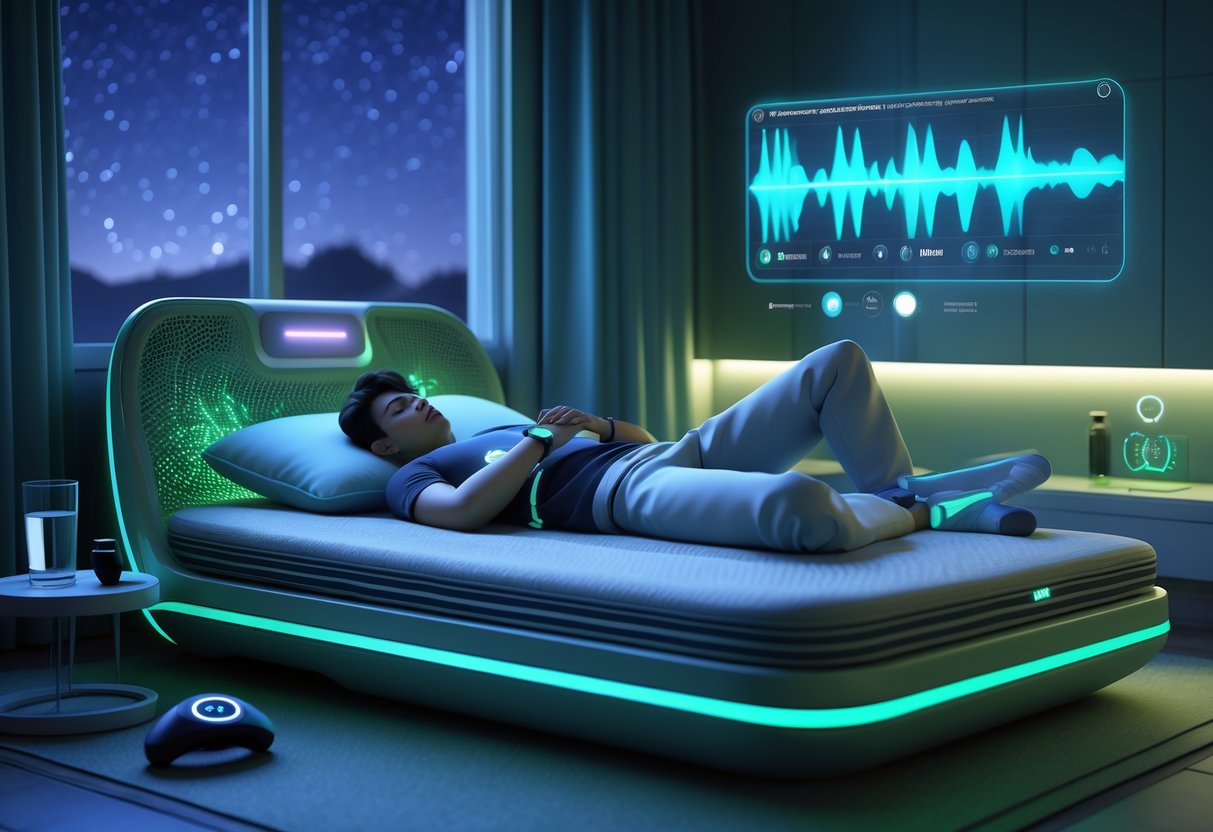
Sleep anchors both physical and mental recovery for competitive gamers. Mental fatigue can hit just as hard as muscle soreness, especially with back-to-back tournaments or marathon practice sessions.
Importance of Quality Sleep
Quality sleep shapes your reaction time, decision-making, and strategic thinking in matches. When you miss out on rest, your brain just can’t keep up.
Studies show sleep loss can slow your reactions by up to 50 milliseconds. In esports, that’s the difference between hitting a clutch shot or missing it completely.
Your brain clears out toxins during deep sleep. Growth hormones peak, repairing muscle tissue and neural pathways.
Bad sleep raises your risk of injury and slows your reflexes. Plenty of pros admit they make silly mistakes after a rough night.
You lock in new strategies and skills during sleep. Training only sticks if your brain gets enough down time.
Strategies to Improve Sleep Quality
Shoot for 7-9 hours of sleep each night, and keep bedtimes steady—even on weekends. Many semi-pros struggle here, but inconsistency really hurts performance.
Build a wind-down routine 2-3 hours before sleep. Skip screens, heavy meals, and caffeine. Try reading, stretching, or meditation instead.
Quick tip: Take a 20-30 minute nap after long practice sessions, but don’t nap after 4 PM or you’ll mess up your main sleep.
Keep your room cool (16-19°C), dark, and quiet. Blackout curtains and white noise can help if your environment is noisy.
Blue light from screens blocks melatonin. Use blue light filters or gaming glasses in the evenings.
Note: Stimulants keep you sharp during tournaments, but they can wreck your sleep for days. Time your caffeine carefully.
Managing Mental Fatigue
Mental fatigue drags your gameplay down just like physical tiredness. Notice when your mind feels fried and allow yourself to step back—don’t feel guilty.
Try 5-minute breathing exercises between matches. Inhale for 4 counts, hold for 4, exhale for 6. This calms your nervous system and lowers stress hormones.
Your nervous system needs breaks after high-pressure games. Take 15-minute pauses between ranked sessions to dodge decision fatigue.
Practice progressive muscle relaxation before bed. Tense and relax each muscle group for five seconds, starting with your toes and moving up.
A lot of competitive players say journaling for 10 minutes before bed clears their head of match worries.
Set up different spaces for gaming and sleeping. Your brain should link your bed to rest, not competition.
Practical Recovery Protocols for Footballers
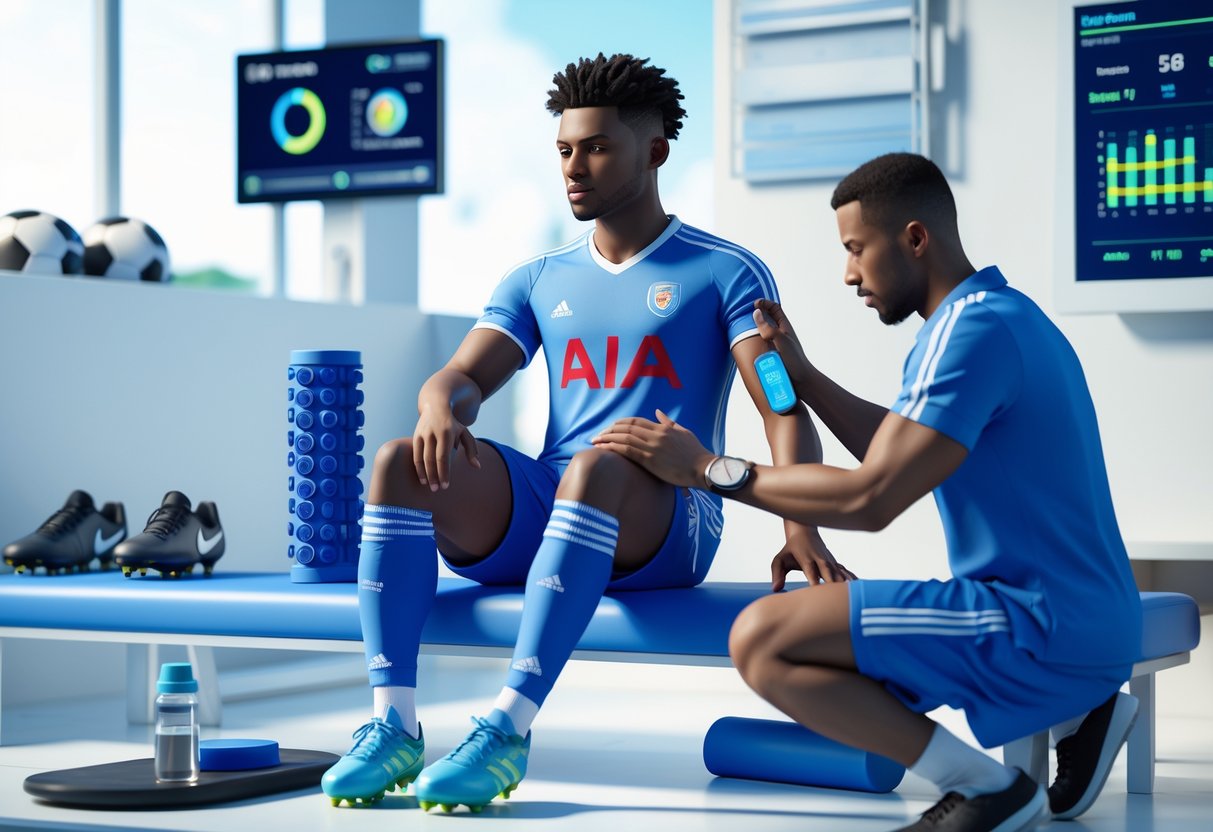
Football recovery needs a plan that tackles dehydration, muscle damage, and glycogen depletion. Teams at every level need flexible systems that work at home, on the road, and during busy weeks.
Post-Match Recovery Routines
The first 24 hours after a match matter most. Start your recovery within 15 minutes of the final whistle.
Immediate Post-Match (0-30 minutes):
- Drink 150% of the body weight lost during the match
- Eat 1-1.2g carbs per kg body weight within 30 minutes
- Begin light walking or gentle stretching
2-6 Hours Post-Match:
- Try cold water immersion for 10-15 minutes at 10-15°C
- Eat 20-25g protein to help muscle repair
- Foam roll major muscle groups for 10-15 minutes
24-48 Hours Later:
- Do active recovery like light jogging or swimming
- Keep hydrating with 35-40ml per kg body weight daily
- Aim for 8-9 hours of sleep for best recovery
Nutrition counts every step of the way. Eat anti-inflammatory foods like berries, leafy greens, and fatty fish.
Travel and Recovery Considerations
Away matches make recovery trickier. Travel messes with routines and limits recovery options.
Before You Travel:
- Pack compression gear for flights longer than 2 hours
- Bring your favorite recovery tools (foam roller, resistance bands)
- Plan your meals around travel times
On the Road:
- Drink water often but don’t overdo caffeine
- Do ankle pumps and calf raises every 30 minutes
- Wear compression socks for trips over 3 hours
At the Hotel:
- Ask for a bathtub for ice baths if possible
- Bring electrolyte supplements and familiar snacks
- Stick to your regular sleep schedule, even across time zones
When facilities are limited, focus on the basics: hydration, food, and sleep matter more than fancy recovery tricks.
Adapting Strategies for Congested Schedules
Playing three matches in a week really cuts down recovery time. You have to get more targeted and efficient.
48-Hour Turnaround Protocol:
- Skip heavy cold water immersion within 24 hours of the next match
- Drop training load to 30-40% of normal
- Boost carbs to 8-10g per kg body weight daily
Priority Recovery Methods:
| Recovery Method | Evidence Level | Time Required | Best For |
|---|---|---|---|
| Hydration | High | Ongoing | All situations |
| Sleep | High | 8-9 hours | Fixture congestion |
| Nutrition | High | Ongoing | Performance maintenance |
| Cold water immersion | Moderate | 10-15 minutes | Muscle soreness |
| Compression garments | Moderate | 2-4 hours | Travel days |
In busy periods, stick to what works best. Sleep is non-negotiable when time is tight.
Mental recovery counts, too. Light activities like reading or music help you switch off between matches.
Monitoring and Individualising Recovery
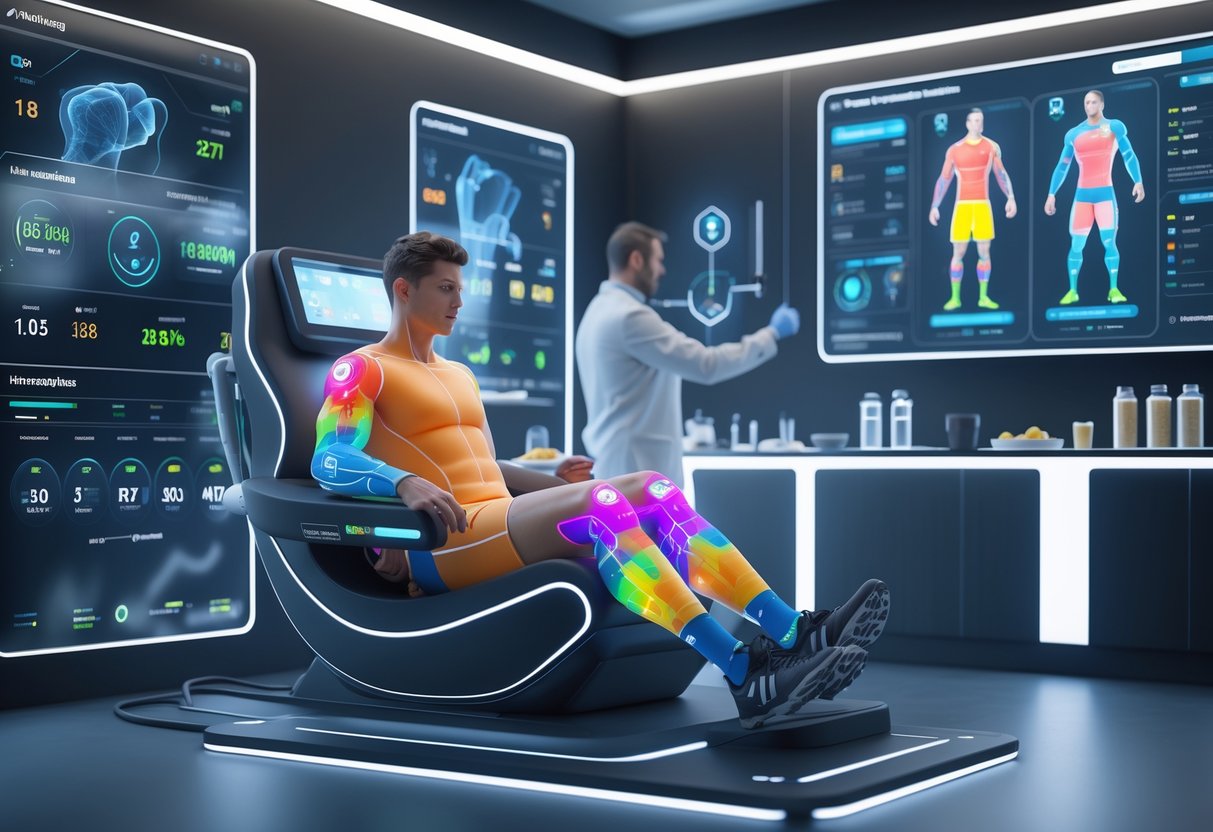
Every player recovers in their own way, so personalised monitoring matters for top performance. Smart tracking lets teams catch fatigue early and tweak recovery plans for each player.
Tracking Performance and Fatigue
We need clear ways to see how players bounce back after matches. Performance markers like sprint speed, jump height, and reaction time show when fatigue is setting in.
Clubs use GPS trackers in training to measure distance, acceleration, and high-intensity work. If numbers drop below normal, it’s a sign recovery isn’t complete.
Biochemical markers give deeper info. Blood tests can check creatine kinase, which rises with muscle damage. High levels mean the body is still healing from the last match.
Heart rate variability is another key sign. We check it each morning with chest straps or apps. Lower variability means the nervous system isn’t ready yet.
Simple wellness questionnaires work surprisingly well. Players rate sleep, soreness, and energy on easy scales. Research suggests these self-scores often predict performance better than fancy tests.
Quick tip: Start with basic morning check-ins rating sleep, soreness, and energy from 1-10. The best recovery programs usually begin with these simple questions.
Personalising Recovery Approaches
Standard recovery plans just don’t cut it. We have to tweak things based on each player’s training load and recovery speed.
Some players bounce back fast after sprints but struggle with contact-heavy games. Others recover quickly from physical battles but need extra time after covering long distances.
Age changes recovery needs. Younger players might get by with less sleep but thrive on active recovery. Older players often need more rest but respond to targeted strength work.
Position matters, too. Centre-backs focus on reducing inflammation from aerial duels. Wingers need strategies to refill muscle glycogen after running all game.
We track how each player reacts to different recovery tricks. One player might love ice baths, another prefers compression gear. Trial and error helps build the right toolkit for everyone.
Don’t assume what works for star players will work for you. Recovery is personal, and copying someone else’s routine can backfire.
Frequently Asked Questions
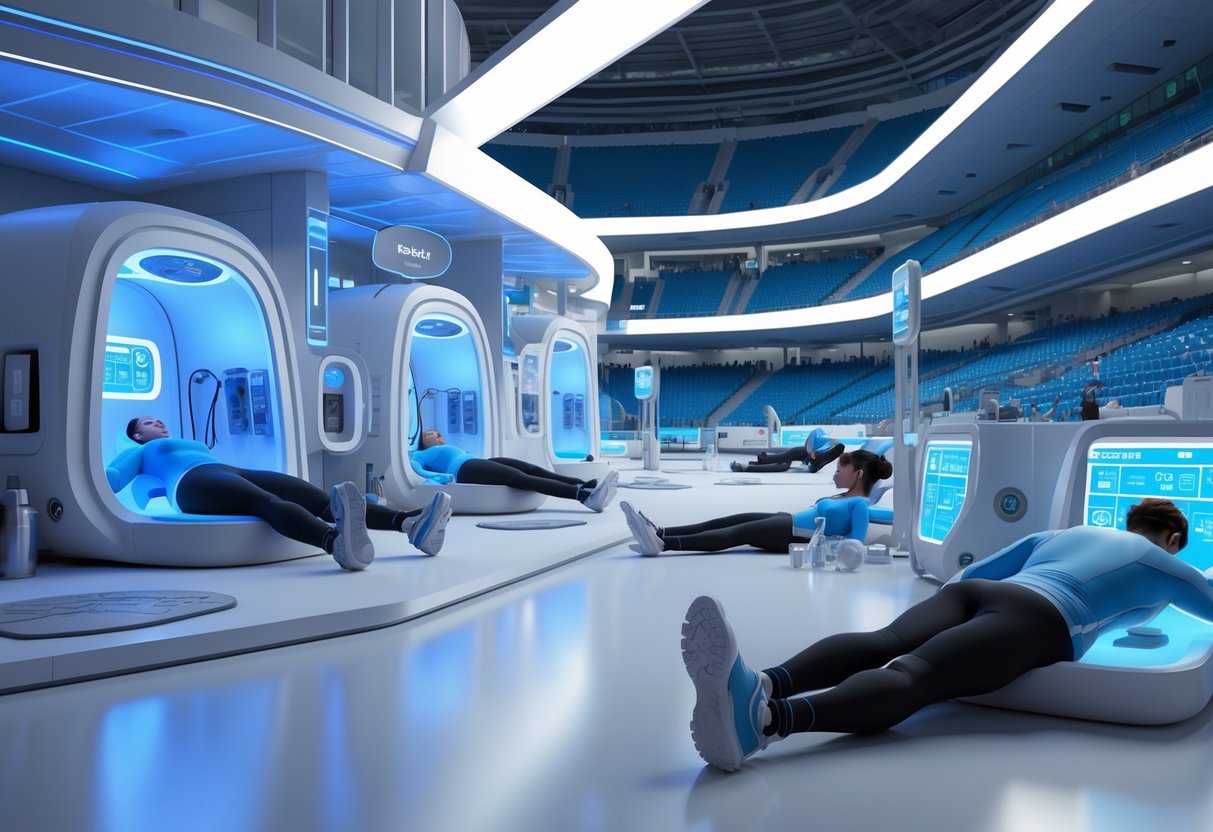
Here are some common questions about recovery that matter for players at every level. We’ll touch on sleep, nutrition timing, and mental prep that actually helps.
How can I optimise my rest periods to improve performance in subsequent games?
Sleep quality counts for more than just hitting eight hours. Your body repairs muscle and refills energy stores during deep sleep.
Aim for 7-9 hours within a day of your match. If you miss a full night, a 20-30 minute nap 6-8 hours post-game helps recovery.
Stick to a regular sleep schedule, even on game days. Going to bed and waking up at the same time trains your body clock.
Keep your bedroom cool (16-19°C) and dark. Lowering your core temperature and blocking light boosts melatonin and sleep quality.
What are the best strategies for muscle recuperation following a competitive match?
Start moving gently within 30 minutes after your game. A 10-15 minute walk or easy cycling helps clear waste from your muscles.
Try contrast showers the next day. Switch between hot water (38-40°C) for 3-4 minutes and cold water (10-15°C) for 1 minute. Do this 3-4 times.
Foam rolling works best 24-48 hours after a match, not right after. Focus on calves, hamstrings, and IT bands for 30-60 seconds each.
Book a sports massage within 2-3 days of tough matches. A pro massage eases muscle tension and boosts blood flow better than doing it yourself.
Are there any specific nutrition tips that help with quick recovery post-match?
Try to eat within 30 minutes after your match. That’s when your muscles soak up nutrients the fastest, since your blood flow is still up.
Pair protein and carbs in about a 1:3 or 1:4 ratio. Honestly, chocolate milk, Greek yogurt with berries, or even a banana with some peanut butter work great.
Drink about 150% of the fluids you lost during the match. Say you dropped 1kg in body weight—aim to drink 1.5 liters over the next six hours.
Add some sodium to your recovery drinks. A pinch of salt in a smoothie or a sports drink with 300–700mg sodium per liter does the trick.
On match nights, take 30–40g of casein protein before bed. This slow-digesting protein keeps feeding your muscles overnight, so you’ll feel better in the morning.
Could you suggest effective cooldown routines to prevent injuries after playing?
Start by walking for 5–10 minutes right after your match. It helps your body wind down and stops blood from pooling in your legs.
Stretch your main muscle groups while they’re still warm. Hold each stretch for about 20–30 seconds—focus on your calves, hamstrings, quads, and hip flexors.
Mix in some dynamic moves too. Leg swings, arm circles, and gentle lunges keep your range of motion better than just static stretching.
Try adding a few minutes of deep breathing at the end. Three to five minutes of slow, diaphragmatic breaths help your nervous system switch from “go mode” to recovery.
What role does sleep play in the recovery process for athletes between events?
Sleep’s huge for recovery. Your body makes about 95% of its daily growth hormone while you sleep, which repairs and rebuilds muscle fibers after matches.
During deep sleep, your brain clears out metabolic waste. If you don’t get enough, those toxins stick around and make you feel foggy or slow.
When you’re sleep deprived, your pain tolerance drops by up to 15%. Suddenly, every bump and bruise feels worse the next day.
Even just one bad night (less than six hours) can spike your injury risk by 70% in the next two days. So yeah, getting regular sleep really does matter.
How can mental preparation and relaxation techniques aid in recovery between competitions?
Try practicing progressive muscle relaxation a couple of hours after your matches. Start from your toes and tense each muscle group for five seconds, then let go and move upward.
During your downtime, use visualisation techniques. Spend about 10-15 minutes picturing yourself pulling off successful plays from your last match—this really helps lock in the good stuff.
If you start to feel mentally wiped out, give box breathing a shot. Breathe in for four counts, hold it for four, let it out for four, then hold again for four.
Do this for five to ten rounds—honestly, it can make a difference.
Try stepping away from social media and match analysis for a full day after your games. Your brain deserves a break from all the noise and second-guessing.
